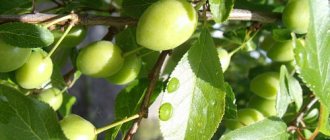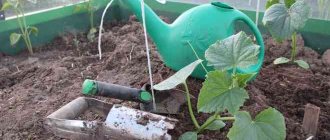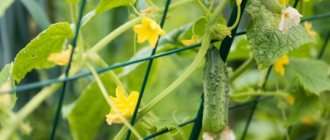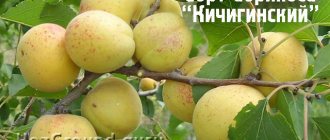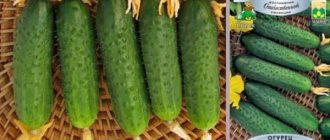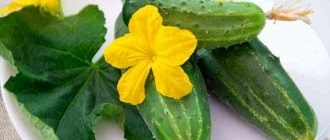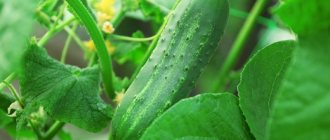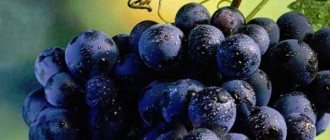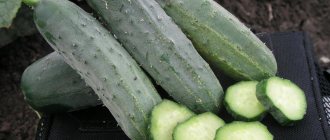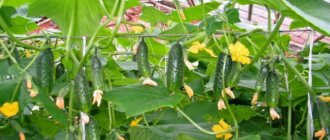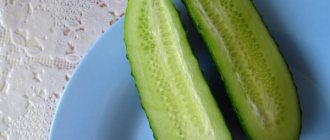The Antilles are considered the homeland of angouria, which is why it is also called the Antillean cucumber. This rare annual plant belongs to the pumpkin family.
Anguria is quite popular in some countries of Europe and America, but in our gardens it is still quite rare. Although she deserves to be noticed by our inquisitive gardeners who love exotic things. After all, it has very beautiful leaves, reminiscent of watermelon, tall (3-5 m) pubescent creeping stems and forms many beautiful light green fruits. The Antillean cucumber can also be used as an ornamental climbing plant, capable of creating tall and very dense green scenes.
Botanical description
Cucumis anguria - Anguria is a liana plant, an annual, belongs to the Pumpkin family, the genus Cucumber. The stems are long, thin and fragile, green, their surface covered with tendrils. The leaves are carved, reminiscent of watermelon. It blooms yellow, the flowers are dioecious and small.
The fruits are not large, elongated, oval in shape, completely covered with soft spines or pubescence, and taste like a cucumber. By the time the seeds ripen, they acquire a yellow-orange color.
One variety can have different fruit colors when grown in different climatic regions. Fruiting begins in July and ends at the first frost. Anguria produces consistently high yields.
The harvest ripens 60-70 days after germination; later the fruits become inedible.
About culture in detail
Of course, anguria is most famous and widespread in its homeland, that is, in Central and South America. Since ancient times, anguria has been widely spread with the help of birds; they loved the contents of the fruit and swallowed the pulp along with the seeds, then scattered to various distances, and the seeds, passing through the gastrointestinal tract and exiting naturally, fell to the ground. And if they found favorable conditions, they sprouted. This is how real thickets of anguria were often formed, which sometimes appeared in the most unpredictable places. In this simple way, Anguria reached the Indian and Far Eastern tropics. But anguria is cultivated not only there, it is also successfully grown in temperate climatic latitudes, where it performs a double function, being an ornamental and cultural plant, that is, its fruits are actively consumed as food, and the plants decorate the site.
Anguria (Cucumis anguria)
Biologically, Anguria (Cucumis anguria) is a vine belonging to the pumpkin family familiar to all of us; it has climbing stems, a large number of tendrils, with the help of which the stems are securely attached to any support, as well as curly foliage, which is similar to that of a watermelon, and yellow flowers. Anguria stems reach a height of 3 m and are distinguished by dense pubescence.
The fruits are cylindrical in shape, they are not very large, usually reach 50 g and extend by about 10 cm (usually less, less often more).
The skin of the fruit is prickly, elastic to the touch, and green in color. Ripe fruits change color from green to yellowish-orange. The pulp of the fruit is strewn with fairly large seeds.
It is interesting that the most valuable fruits are those that are not collected at full ripeness, but when they are still immature. Typically, fruits at this stage of maturity can be harvested 70 days after the emergence of seedlings obtained from sowing seeds.
If you delay in collecting fruits, their pulp will become unpleasantly sweet and, one might say, unsuitable for food, but unripe fruits taste much more pleasant. In addition to fresh consumption, Anguria fruits are successfully salted and pickled, after cutting off the spines.
The Anguria variety has been listed in the State Register of Breeding Achievements of the Russian Federation since 2013.
Dietary - for growing in all regions under temporary film covers. Recommended for eating young fruits (technical ripeness) fresh and for canning. The period from emergence to the first harvest of fruits is 48-50 days. Bee pollinated. The plant is climbing, characterized by strong growth and high shoot-forming ability. The stems are thin, fragile, pubescent with tendrils. The leaves are dissected, light green or green. The fruits at technical ripeness are oval, light green in color with longitudinal white stripes, pubescent with white spines, 5.3-6.5 cm long, weighing 43-46 g (up to 50 g). The pulp of the fruit is greenish-yellow, juicy, medium-density with a cucumber aroma. The taste is sourish, good. 45-50 fruits are formed on the plant. The yield of marketable fruits at technical ripeness is 7.15-8.24 kg/sq.m. The fruits retain commercial quality for 7-10 days.
Anguria, or watermelon cucumber (Cucumis anguria)
Why do the varieties have different names?
The name "Anguria", according to some sources, in Sanskrit denotes a homonym of one of the rulers of India, who had several tens of thousands of children, hinting at the large number of seeds in the plant. The Slavs pronounced this word as “cucumber”, from which the name “cucumber” came.
Today you can find the following plant names:
- Antillean cucumber - comes from the name of the plant’s homeland;
- Horned cucumber or hedgehog cucumber - because of its appearance;
- Machiche (maxixe) is the name given to this plant in Brazil.
You can often hear that Anguria is called a watermelon cucumber, hinting at the similarity of the leaves of these plants. But in fact, this is the correct name for another type of plant - rough melotria (Melotria shcabra or Cucamelon, or Mexican cucumber / Mexican watermelon). Melotria fruits look like small cucumbers with watermelon colors (unlike anguria, melotria fruits do not have thorns). Their taste is also similar to cucumber.
Growing Antillean cucumber - care, varieties, properties
Details
Category: Growing Plants
Anguria or Antillean cucumber (Pumpkin family) is a rather rare plant in cultivation and is not found growing wild at all. The Antilles are the birthplace of this plant (as is commonly believed). This is where the name comes from - Antillean cucumber (it also has other names - kiwano, horned melon, Milano). It is mainly grown in the United States of America and Great Britain, but recently it has begun to appear on the plantations of Ukrainian and Russian amateur gardeners.
Biological features
An annual plant, reaching up to 2.4 m (7 ft 10 in), but sometimes larger, with many side shoots that cling to the support with tendrils, so it is best grown near arbors, walls and other supports. The leaves look like watermelon. A fairly heat-loving plant (ideal temperature 22-27°C), it dies at low temperatures, and even more so during frosts.
Flowering occurs from July to September, and fruits ripen from August to October. The flowers are monoecious, individual flowers are male or female, but both sexes can be found on the same bush). This crop is closer to cucumber, the fruits are somewhat similar (anguria is more tender and sweet), but they have a small and spherical shape, covered with thorns; they are removed before use. It should be noted that when ripe they are inedible.
The average weight of the fruit is 300 grams, the average length is about 12 cm. A distinctive feature of anguria is its riotous flowering and floridness; it can be used as an ornamental plant. The Antillean cucumber, unlike the regular cucumber, is more resistant to disease. You can prepare salads from the Antillean, preserve (mainly seven-day-old fruits are used) or pickle in the same way as all types of cucumbers. The fruits are also distinguished by their decorative beauty, thanks to which they can be used to create extraordinary compositions (they can be used as original Christmas tree decorations).
Growing Anguria
In Russia, it is optimal to grow Antillean cucumber in a greenhouse (the desired temperature can be maintained and controlled for a long time). In the southern regions, where high temperatures last a long time in summer, cultivation in open ground is possible. It does not require special care, just note that you need to water it with warm water less often than a regular cucumber, but using abundant watering (on average 13 liters per 1 m2). Anguria needs regular watering during fruiting. As soon as the first ovary appears, you need to pinch the plant (promotes the active growth of shoots of the second row, and, accordingly, the yield). During the season, about five feedings are carried out, alternating mineral and organic fertilizers. To preserve the freshness of the fruit, harvest in the morning. If you care for anguria properly, the fruit harvest will last until autumn.
Varieties, varieties of Anguria
Only one variety is officially recognized in the Russian Federation - Dieticheskiy (included in the State Register of Breeding Achievements in 2013), but gardeners also plant imported varieties - Anguria Antilles (Kiwano), Syrian.
The Dietetic variety is distinguished by early ripeness, strong branching, has drooping, thin stems, green leaves, dissected. Like all varieties, it is recommended to grow in greenhouses. The variety is pollinated by bees. Characterized by high productivity (about 8 kg per sq.m.).
Beneficial features
Anguria contains a large amount of mineral salts, which are similar in their effects to ordinary cucumber, so the fruits are widely used in dietary and therapeutic nutrition for patients with cardiovascular and gastrointestinal diseases. The plant contains carbohydrates, proteins and fats, a fairly large amount of ascorbic acid, β-carotene and vitamins B and P, a lot of potassium, iron, zinc, copper and manganese. It is also recommended to use for kidney disease, obesity, anemia, and atherosclerosis. Widely used in folk medicine for wound healing, because contains an astringent.
In addition, anguria juice is a good sedative, which also relieves insomnia and heart pain. It is also important that Antillean cucumber juice helps remove radionuclides and toxins from the body.
The fruits of this strange plant can be stored for a long time, retaining the taste and smell of cucumber and without losing their healing properties.
Social Like
Characteristics
Table of the main characteristics of the Antillean cucumber:
| Liana length, m | Fruit length, cm | Fruit width, cm | Fruit weight, g | Productivity, fruits/plants | Growing season, days | Temperature for cultivation, °C |
| 4-6 | 8-10 | 4-6 | 30-50 | up to 200 | 60-70 | 20-27 |
The fruits have good shelf life, while retaining useful elements.
Use Anguria:
- fresh;
- salted;
- pickled.
Description of culture
Cucumis anguria - Antillean anguria, Antillean cucumber or Kiwano. It is a creeping plant, has a 3.5-6-meter stem. Anguria leaves resemble small and hard cucumber or watermelon leaves and have small sharp thorns.
“Hedgehog cucumber” or “horned cucumber” is how the Antillean anguria is called for its fruit. Its fruits are light green in color and oval in shape. Their sizes are up to 8-12 cm in length, up to 4 cm in thickness. On average, one fruit weighs 200-400 g.
Anguria fruits are covered with large thorns, fleshy and juicy. These cucumbers hang on long stalks.
Advantages and disadvantages
The advantages of Antillean cucumbers include:
- decorativeness of the plant;
- excellent taste;
- rich vitamin composition;
- care does not differ from care for other melons;
- low susceptibility to diseases and pests.
The disadvantages include:
- thermophilicity;
- demanding on soil moisture;
- requires constant fertilizing;
- Rarely used as food by residents of the CIS countries.
Growing the variety
Anguria is planted in warm, sunny areas, protected from drafts and strong winds. The culture prefers light and fertilized soils with good drainage. You should not plant plants in acidic soils or areas where groundwater is close to the surface.
Since the bushes climb and have a considerable height, they need support in the form of a wall, fence or trellis.
The best temperature for growing plants is +25…+26°C; lowering the temperature to +6°C or lower leads to their death. When mature, the plants are better cold-resistant, but during the cold season they produce only a modest harvest.
Growing seedlings
To get a full harvest, it is better to grow this crop from seedlings.
To do this you should:
- Select large, high-quality seeds.
- Soak the seed material in clean, lukewarm water for a day; you can use a light solution of potassium permanganate.
- Prepare a soil mixture of peat and humus in a 1:1 ratio.
- Fill disposable cups with a diameter of 8–10 cm with soil and sow 1–2 seeds in them.
- After 25–30 days, transplant the resulting seedlings into a greenhouse.
- When the earth warms up to +10°C (late May - early June), plant Anguria on the site.
Seedling care
Caring for Anguria seedlings is no different from caring for ordinary cucumbers. Containers with sown seeds are covered with film or glass and placed in a room with a temperature of about +25°C.
Water no more than once every 7–10 days. Watering is done with room-settled water so that the soil does not dry out and the water does not stagnate.
For normal ventilation, the cups are placed at some distance from each other. After a week, when two leaves appear on each sprout, the protection is removed and the containers are exposed to sunlight. In this case, it is necessary to ensure that not direct, but scattered rays of the sun fall on the seedlings.
To reduce the density of seedlings, diving is carried out at the stage of formation of 2-3 leaves.
Transplanting
Depending on the climatic conditions of the area, Anguria Antilles seedlings are planted in a greenhouse or open ground.
To the greenhouse
Plants are planted in a greenhouse when each bush has 5-6 formed leaves. This culture does not like transplantation, so you should be very careful.
You need to cut the cups, remove the bush along with a lump of earth, transplant it into prepared holes and fill it up to the cotyledon leaves. Then compact the soil slightly, lightly water and mulch the soil in the root circle.
In open ground
Plants are planted in open ground at a steady day temperature of about +22°C and a night temperature not lower than +18°C. Seedlings are planted when each bush has 3-4 formed leaves.
The standard pattern for planting seedlings is 50x40 cm. When planting near a building or fence, the distance between the bushes should be increased to 80 cm. 2 liters of humus and a handful of wood ash should be placed in each prepared hole. Then plant the bushes, deepening them to the cotyledons.
If there is no natural support on which the lashes can crawl, an artificial one is installed.
Anguria varieties
Only one variety is registered in the state register - Anguria dietary . Recommended for growing in greenhouses and greenhouses. Early ripening, ripens in 47-52 days. The plant has high rates of shoot formation and weaves well. The stems are thin and fragile. The fruits are light green in color, with white stripes and soft spines, oval in shape, up to 6 cm long. The pulp is yellow-green, medium-dense, juicy, and has a high taste.
Fans of this plant mainly cultivate foreign varieties.
Also often grown:
- Variety Anguria "Gourmet". It is grown as a vegetable and ornamental crop. The vines grow about 3 m long. The fruits are oval, light green, with large, juicy thorns. Young fruits are eaten; overripe fruits, when they change color, can be dried and used in floral arrangements.
- Anguria Syrian variety . The variety is distinguished by early ripening, vine sizes up to 4 m, and a large number of shoots. The fruits are up to 7-8 cm in size, weighing up to 50 g, covered with small thorns. Young fruits have high decorative properties, look beautiful on the plant and as a decoration for dishes, sweet in taste, light green in color. Fruits from July until frost. Grown on trellises.
Kiwano (Cucumis metulifer or horned melon or African cucumber) is considered a relative plant very similar to anguria. Its fruits are dark green in color and have large, fleshy spines. Weight up to 300 g. The taste is cucumber with notes of either banana or something else.
Anguria “Gourmet”
Anguria Syrian
Kiwano
What is Anguria
Anguria's natural habitat is tropical and subtropical climatic zones. Its second name is Antillean cucumber, it belongs to the genus Cucumis (Cucumber) of the same name and the Cucurbitaceae family.
In the wild, the plant, which has a bitter taste, was first discovered in South Africa and Madagascar, and over time the seeds were brought to America. In Australia, the vegetable is considered a weed and regular work is carried out to destroy it in areas.
In Russia, many gardeners are already trying to grow anguria as a fruit and ornamental crop.
Agrotechnical features
Anguria is a heat-loving plant. When the temperature drops to +10 °C, it stops growing. When temperatures rise, growth resumes; when temperatures drop below 5-6 °C, the vine dies.
The place where the Antillean cucumber will grow should be well warmed by the sun and protected from the wind. The plant does not like shade and dense plantings. Ideally, the bed should be located on a hill where rainwater does not stagnate.
The soil should be fertile and well drained. Chernozem or sandy loam soil with neutral acidity is suitable.
Acidic soils and close proximity to groundwater can destroy the plant.
If the required soil is not available in your region, it can be corrected by adding a sand-peat soil mixture to the site. To reduce acidity, lime must be added.
In the selected area in front of Anguria, legumes, root vegetables, greens, and early cabbage can grow.
Horned cucumber will not grow well in a garden bed where the predecessors were any pumpkin crops.
Secrets of growing Anguria
The Antillean cucumber is a heat-loving plant because it is of tropical origin. But with proper care, the fruits can be grown in temperate zones. The optimal temperature range is from +20°C to +29°C, a mark of +32°C or a decrease to +8°C are considered critical.
For planting Antillean cucumber, it is better to choose fertile black soil or neutral sandy loam soil. To reduce acidity, you can add lime to the soil. It is recommended to plant the plant in beds where beets, cabbage, legumes, and herbs were previously grown.
Important ! You cannot choose soils with close groundwater for anguria - they will provoke rapid rotting of the root system.
The growing area should be well-lit and sunny; the exotic cucumber does not tolerate shading and does not like drafts. Considering that the period from germination to fruit harvesting is about 55 days, it is better to plant the crop as seedlings.
Planting Anguria seedlings
The best time for sowing seeds for seedlings is considered to be the beginning of April.
Procedure:
- Seed selection. Sort through the seeds, select only large ones.
- Disinfection. Disinfect planting material in a solution of potassium permanganate.
- Using a root former. The day before germination, soak the seeds in a rooting agent solution, for example, Epine.
- Germination. Place the seeds on gauze folded in several layers and cover with the same gauze on top. Place in a warm place and make sure that the fabric does not dry out. When the seeds hatch, you can replant them.
- Transfer. Use peat tablets, this will preserve the root system when transplanting into the ground. Rules: fill the peat tablet with water for 5 minutes;
- after it increases in height, drain off excess water;
- increase the recess in the middle to 1 cm;
- put a seed in it and seal it.
You can use peat or paper cups 8-10 cm deep, filled with soil mixture for seedlings.
- First shoots. Expect it in a week.
- Bedding. When 2-4 true leaves appear on the stems, the seedlings can be transferred to the garden bed.
To prevent the Anguria stems from stretching too long due to lack of light, additionally install fluorescent lamps above the seedlings.
Features of growing Kiwano
Horned cucumber bears fruit in short day conditions. There is no need to sow kiwano seeds early for growing in open ground or a greenhouse. The plant blooms in the second half of summer.
Growing kiwano in the Moscow region
According to reviews, growing kiwano in the middle climate zone is best practiced in greenhouses. Flowering in August does not allow all the fruits to fully ripen. Although some are picked for ripening, and the vegetables may acquire a sweet taste, most remain small, with green skin. Such unripe vegetables are used for pickling or pickling. During the growing process, it is necessary to limit the violent growth of kiwano vines, otherwise they will inhibit the ordinary cucumbers with which exotics are planted. The cultivation of a domestic variety bred by Novosibirsk breeders will be successful.
Growing Kiwano in Siberia
For temperate climate conditions, Novosibirsk residents developed a variety of African cucumber called the Green Dragon. The growing season of the plant does not depend on the amount of daylight, flowering occurs earlier, the bulk of the crop sown with seeds in April ripens in the greenhouse before frost. The first fruits of the Green Dragon variety ripen by mid-summer. Domestic kiwano seeds are sown in April. After the one-month seedling stage, it is transferred to a film greenhouse, but only when the temperature is above + 18 °C. If there is no heat, there is a risk of losing young seedlings.
Planting in the ground or in a greenhouse
Seedlings are planted in the ground approximately 20-25 days after sowing the seeds.
A good harvest, in our latitudes, can be obtained by growing Anguria only in a greenhouse.
Planting rules:
- Scheme. Plant the Antillean cucumber following the pattern - 50x40 cm. If you need to plant plants along the fence, mark the seedlings at a distance of 80 cm from each other.
- Neighbors in the garden. Step back about 50 cm from neighboring plants so that they do not shade the cucumbers. Corn can be planted on the windward side as a living windbreak. Umbelliferous plants such as coriander, dill, and parsley, planted nearby, will promote cross-pollination and increase productivity.
- Holes. Dig holes deep enough for the seedling to fit completely into it.
- Fertilizer. Add 2 liters of humus to each hole. You can add 1 handful of ash to the humus.
- Disinfection. You can prevent the development of diseases by watering the hole with a weak solution of potassium permanganate.
- Watering. Moisten the soil by pouring enough water into each hole. This point can be skipped if disinfection was carried out with potassium permanganate.
- Landing. Cover the plants with soil up to the cotyledons.
- Supports. Install trellises along the rows. When the seedlings grow to 20 cm and have mustaches, they should be directed to the trellis.
Seedlings can be planted in open ground after it has warmed up well, to at least 10 °C.
Anguria can be grown in tubs for the purpose of landscaping balconies. Planting and care, as in open ground conditions. You should take care of the vertical supports in a timely manner, and by stretching the mesh over the top, you can create a canopy.
Anguria (Antillean cucumber) for gourmets: cultivation and care
Anguria is a plant of the Cucurbitaceae family, similar to a prickly cucumber. Anguria can be eaten like traditional cucumbers and momordica, but most often the plant is grown as an ornamental.
The Antillean cucumber is a close relative of ordinary cucumbers - the plants have a common South American origin, the fruits are similar in size and shape. The leaves look like watermelon. There is only one difference - thorns, or rather thorns.
Young fruits of Anguria Antilles can be eaten, so experienced gardeners grow Antillean cucumber for food purposes. Young Anguria fruits taste like cucumbers. The fruits are eaten raw or pickled.
The pickled fruits of the Antillean cucumber are tastier than pickled cucumbers; the spines are still tender at this time, so the Antillean cucumber is considered a delicacy among gourmets.
At a later age, Anguria fruits are not edible. Therefore, ripe fruits are used as beautiful souvenirs, surprising guests with their beauty and unusual shape, and they are stored for quite a long time. At exhibitions of fruits and vegetables, Anguria fruits always attract great interest.
Anguria (lat. Cucumis anguria, syn.
Watermelon cucumber, Antillean cucumber) is an annual liana-like plant with long (3–4 m) creeping pubescent stems with numerous tendrils, figuratively carved leaves, and yellow flowers.
The fruits are cylindrical, small, 8 cm long, 4 cm in diameter, weighing 30–50 g. Covered with soft fleshy spines or smooth with slight pubescence. The taste is reminiscent of a regular cucumber.
The entire life cycle of Anguria in one picture. Fair Dinkum Seeds
By the time seed ripeness occurs, Anguria fruits acquire a yellow-orange or red color; biological ripeness occurs approximately 70 days after emergence. Young anguria fruits are eaten raw or pickled, salted. At a later age, Anguria fruits are inedible or sweetish.
Anguria grows in Central and South America, India and the Far East. Thanks to its excellent taste, it is eaten by birds and small animals, which spread seeds around the area.
Anguria was cultivated by American Indians in ancient times. Nowadays, Anguria is cultivated both as a vegetable and as an ornamental crop. (Wikipedia)
Beneficial properties of Antillean cucumber
Anguria fruit in cross section. It is clearly visible that the fruit resembles an ordinary cucumber. Laboratorio de Calabazas
Thanks to their rich chemical composition, anguria fruits have a positive effect on human health - they are useful for chronic diseases of the stomach and intestines, as well as for cardiovascular problems.
Unlike traditional cucumbers, Anguria fruits do not accumulate nitrates and are never bitter. Therefore, Antillean cucumbers are well suited for salads and for fresh consumption.
The taste of the Antillean cucumber is reminiscent of a mixture of cucumber and banana, with an admixture of watermelon notes. Young anguria fruits have soft thorns, but old fruits are not eaten, but are preserved for drying. Dried Antillean cucumber is stored for a long time, delighting owners with its exquisite shapes.
By the way, dried, ripe anguria fruits make original Christmas tree decorations.
Growing Antillean cucumbers
In addition to its beneficial properties, anguria is valued for its decorative properties. The plant is climbing, so it needs reliable support, a trellis. Therefore, to decorate the garden, anguria is planted in sunny places, along the south side of houses and fences (anguria cannot be planted in the shade).
Anguria leaves are similar to watermelon leaves. Eugenio Hansen
Anguria flowers are small, dioecious, yellow in color. A large number of flowers decorate the garden during the warm period, right up to frost. Bees happily pollinate the flowers of the Antillean cucumber, so you definitely won’t be left without fruits.
Antillean cucumbers are popularly called “hedgehogs”. By the time they reach seed ripeness, they acquire a bright yellow-orange color. Biological ripeness of the fruit occurs approximately 70 days after emergence.
One plant produces up to 80 fruits per season, with proper care and the absence of early cold weather. In our conditions, Anguria bears fruit from July to September.
Like cucumbers, Anguria loves warmth . The optimal temperature for plant growth and development is + 25-26° C.
Anguria can hardly tolerate temperatures below +12-13° C below +5...+6° C it dies.
Mature plants are more cold-resistant than young ones because they adapt to the climate, but you should not expect a decent harvest in the event of a cold summer.
Anguria loves moisture and prefers fertile soils with good drainage. Anguria does not tolerate acidic soils and high groundwater levels.
By the way, the best predecessors of anguria are green vegetables, legumes, table root vegetables and early cabbage.
Growing Anguria seedlings
Anguria seedlings are grown by sowing large seeds tested for germination. Before planting, seeds are disinfected and soaked in a solution of fertilizers and microelements, germinated until single seeds peck, dried until they flow and sown like a cucumber.
The plant does not tolerate transplantation well, so it is advisable to grow Anguria seedlings in separate cups with a diameter of 8-10 cm. Caring for seedlings is similar to growing cucumber seedlings.
Anguria seedlings are planted in a greenhouse or in open ground under a film at the age of 20–25 days, next to supports. A good harvest of Antillean cucumber fruits can only be obtained in a greenhouse .
Canned Anguria greens. Jerry Coleby-Williams
Planting seedlings in a greenhouse or open ground
When planting seedlings in a hole, you need to put two liter jars of humus and a handful of ash, which are mixed well with the soil. Plants must be buried down to the cotyledons. The scheme for planting seedlings is 50x40 cm. When planting plants along the fence on the south side, the distance between plants must be increased to 80 cm.
How to care for Antillean cucumbers
It is recommended to feed Anguria with a solution of mullein or chicken droppings, or a solution of nitrophoska (3 tablespoons per bucket of water) every 10 days.
The plant responds well to foliar feeding (from a leaf sprayer). For foliar feeding, it is recommended to use a complex of mineral fertilizers containing nitrogen, phosphorus, potassium and microelements at a concentration of 0.25%.
Anguria is watered abundantly, especially during fruiting, although the Antillean cucumber tolerates a temporary lack of moisture in the soil more easily than ordinary cucumbers.
Anguria is pinched to cause abundant fruiting. After the first ovary appears, the tops of all vines must be pinched to cause rapid growth of fruiting shoots of the second order.
By the way, Anguria is resistant to powdery mildew, unlike ordinary cucumbers.
Save as a memory!
Write to the editor: I know more about this... I want to suggest a topic!
Sources:
- Anguria – Wikipedia
- Cucumis anguria – wikipedia.org
Source: https://good-tips.pro/index.php/house-and-garden/orchard-and-garden/vegetables/cackrey-cucumis-anguria-planting-care
Further care
Caring for the plant is not very different from caring for ordinary cucumbers.
After the first ovary appears, the Antillean cucumber vines are pinched so that second-order shoots begin to develop quickly.
Watering
Although Anguria tolerates drought better than ordinary cucumbers, it should be watered regularly, especially during the fruiting period. At the same time, do not allow the soil to become waterlogged. Otherwise, fungal diseases may develop.
Irrigation features:
- water when the soil dries, but does not dry out until cracks form;
- Prepare the water in advance, it should be settled and warm;
- the ground around the trunk should not become swampy;
- water the plants under the bush;
- in dry and hot weather, water Anguria every day in the evening;
- during the rainy season, avoid watering.
Feeding
In order for the plant to develop well and bear fruit, it needs to be fed every 10 days.
To do this, prepare one of the solutions:
- Mullein. Humus in the amount of 1/4 of a bucket is mixed with a bucket of water. The solution is left in a warm place for several days to ferment. 1 bucket of solution is diluted in 3-4 buckets of water and the plants are watered in an amount of 10 liters per 1 square meter. m.
- Chicken droppings. To prepare, fill half a bucket with droppings and top up with water. Leave the fermentation solution in a warm place. Before adding, dissolve 1 liter of manure in 10 liters of water. It is better to fertilize after rain; in dry weather, 2 hours before application, thoroughly water the bed.
The concentrated solution can be stored all summer and used if necessary.
- Nitrophoska. Complex mineral fertilizer, as a top dressing, is used by dissolving 3 tbsp. l. in 10 liters of water. 0.3-0.5 liters are poured under each bush.
- "Solution." To provide the plant with phosphorus, sodium and potassium, it is added after the appearance of 5-6 leaves. A solution is prepared from 10 liters of water and 10-15 g of fertilizer.
Experienced gardeners advise alternating the application of mineral and organic fertilizers.
Planting and caring for anguria
By and large, you need to grow anguria in the same way as cucumbers. Their agricultural technology is similar, but the exotic crop in the middle zone did not have time to acquire a large number of diseases and pests.
Preparing the landing site
Good precursors for anguria will be legumes, any greens and root vegetables. The soil needs to be dug up, weeds must be removed along with the roots, and if necessary, humus, peat and sand must be added. If the soil is acidic, before loosening the surface is covered with lime or dolomite flour, depending on the pH level - from 0.5 to 1 liter per 1 square meter. m.
It is best to dig up the area in the fall, and before planting the Antillean cucumber, simply loosen it with a rake. In any case, the operation is carried out no later than 2 weeks before sowing anguria seeds or moving seedlings into open ground.
Advice! If, after all, digging of the soil was carried out immediately before planting the crop, it is recommended to water the bed with a hose so that the soil subsides a little.
Seed preparation
In the southern regions, anguria can be sown directly into the ground. In the north, it is better to first grow seedlings in peat cups - the Antillean cucumber, like a regular one, does not like its roots being disturbed. Consequently, there can be no talk of any picking or transplanting from common boxes.
Anguria seeds are prepared in the same way as regular cucumbers - heated or soaked. Planted in a nutrient mixture to a depth of 1 cm and watered generously with warm water. Keep at a temperature close to 22° C, high humidity and good lighting. The best place for Antillean cucumbers is a southern windowsill.
Before moving into the ground, Anguria seedlings must be hardened off. Within 10 days they begin to take her outside - first for 2 hours, but every day the time spent in the fresh air increases. For the last 2 days, Antillean cucumbers have not been brought indoors even at night.
Growing anguria from seeds by sowing them directly into the ground is not difficult, it just takes longer, and in the northern regions the first harvest will be received late. And the culture will not last long as a decoration for gazebos - even with a short-term drop in temperature to 8°, the Antillean cucumber may die.
Landing rules
When the seedlings have formed 2 pairs of true leaves, and the soil temperature is 10 ° C or more, the threat of return frosts has passed, Anguria can be planted in open ground. If the weather permits, it is better to work on a warm, cloudy day.
The holes for the Antillean cucumber are made at a distance of 50 cm from each other, in one row. A handful of rotted humus and ash is poured into each and thoroughly mixed with fertile soil. You can replace organic matter with mineral fertilizers, for example, a tablespoon of nitroammophoska.
Water the holes well, when the water is absorbed, plant the Antillean cucumber seedlings. It is better to place the support right away - in the open ground, in a week, anguria can grow by 20 cm, and it needs to cling to something. The recommended trellis height is 120-150 cm.
Watering and fertilizing
Anguria needs frequent, abundant watering. The water should be warm, or the same temperature as indicated by the outdoor thermometer. Cold weather is likely to cause illness and, possibly, death of the Antillean cucumber.
The soil must be constantly moist. In hot, dry summers, anguria will have to be watered daily, at first spending 2 liters per root. A month after planting seedlings in open ground, the need for water will double.
Advice! Watering the Antillean cucumber should be done in the evening or early in the morning, trying to get it into the hole and not wet the leaves.
It is impossible to grow anguria without regular fertilizing - the vine grows large, produces a lot of greens, and applying fertilizers gives it all the substances necessary for life. If the Antillean cucumber decorates the area, there should be no problems. But supporters of organic farming should think in advance about how they will feed the crop, prepare ash, mullein, or leave green fertilizer to ferment.
Anguria is fed every 2 weeks, ideally alternating organic and mineral preparations. If you dilute purchased fertilizers according to the instructions, the mullein infusion is 1:10, and the herb infusion is 1:5, it is enough to pour 0.5 liters under the root.
The Antillean cucumber has a delicate root system, so fertilizing should be diluted with water. Dry ones should not be added, even if they are well embedded in the ground.
Anguria is very fond of foliar feeding, but if the greens are used for food, they can only be done before flowering begins. To do this, you can use special fertilizers, or dilute 2 teaspoons of nitroammophoska in 10 liters of water.
Important! If spraying Anguria is carried out with infusions of mullein or herbs, they must be carefully filtered.
Topping
Anguria grown as an ornamental crop is often not pinched at all. Here the task of the vine is to weave the support as thickly as possible to create maximum decorativeness.
It’s another matter when they want to get a good harvest of Antillean cucumbers. Then the main shoot is pinched, the 3-4 lowest side shoots are completely removed - they practically do not produce a harvest, since they are in the shade and only take away nutrients.
The remaining side shoots are shortened as soon as they grow a little. When the main shoot is thrown over a horizontally stretched wire, pinching is stopped. This is how Anguria will produce a full harvest. Perhaps it will not be as abundant as in the wild, and the owners will receive half or three times less greens. But they will be large, beautiful and tasty.
Diseases and pests
The Antillean cucumber is rarely affected by common fungal diseases or pests.
Table of possible diseases:
| Types of diseases | Names of diseases | Causes of defeat | Solution |
| Fungal | powdery mildew | Most often develop when:
| Treatment involves:
|
| anthracnose | |||
| root rot | |||
| white rot | |||
| Pests | spider mite | Violation of humidity, both upward and downward | Insecticides used:
|
| melon aphid |
When treating with chemical products, take into account their decay periods. Harvesting is prohibited at this time.
Propagation of Antillean cucumber
Being an annual plant, there is no point in growing the Antillean cucumber by cuttings or shoots; it is grown only from seeds. In the Russian climate, it is preferable to grow Anguria using the potted seedling method.
Sometimes, if seed germination is low, some gardeners advise:
- pinch off a shoot up to 15 cm in size;
- remove 2 leaves from below;
- put it in a growth stimulator for 24 hours;
- plant on the garden bed, covering the top with a jar.
After 2 weeks, the bait should take root and begin to grow.
Delicious beauty and its description
If you have been gardening every year for many years, then the time comes when you want to grow something unusual and interesting, to replace the already boring varieties of cucumbers, peppers and tomatoes. In addition, visible diversity will attract the attention of neighbors and surprise passersby. You should not start with rare and ornamental varieties, the cultivation of which will require special conditions. One of the unpretentious varieties is CucumisAnguria, or it is also called Syrian Anguria, or Antillean cucumber.
Early morning, when the fruits have not yet been heated by the morning sun, is ideal for harvesting. This way they will stay firm and last longer.
The plant is an annual plant and has a vine-like pubescent stem that can reach a length of three meters. It has a huge number of side shoots. The leaves are slightly dissected and resemble watermelon in appearance. The fruits themselves are small and weigh only 25 grams; if they are fully ripe, they become twice as large and heavier. They have an oval and slightly elongated shape with a greenish color and a row of spines. The juice, like the fruits themselves, is extremely healthy. When fresh, they are used like ordinary cucumbers - to make salads, pickle and pickle.
Growing Anguria Plant
At least 55 days must pass from the moment of germination to the appearance of the first fruits. This applies to all Anguria varieties without exception. Summer in most regions of our country is short, and heat is not enough for them, therefore, to accelerate growth and subsequent fruiting, it is recommended to use pre-germinated seedlings. Before sowing the seeds, you should keep the seeds in a solution based on a growth stimulator for forty minutes.
They are treated with a weak solution of potassium permanganate, after which they are immediately thoroughly washed with running warm water. A warm place and a slightly damp cloth are perfect for germination. There is no precise time frame at which it would be possible to find out the date of harvesting of young seedlings, but approximately 25 days are counted before the date of intended planting in the ground.
Germination is carried out in the same way as when using regular cucumber seeds. At the moment when the first lashes appear, all seedlings are pinched. In this way, side shoots will begin to sprout, which will lead to the formation of female inflorescences.
In ornamental gardening, as in ordinary gardening, it is recommended to use peat pots or other containers for seedlings, which, when planted in a permanent place, will not damage the fragile root system of the plant. Otherwise, it will often get sick and need special care. However, for most regions, the only way to grow the fruits of this plant, which are used in cooking, is to use equipped greenhouses.
The flowering period, as well as subsequent fruiting, is very long, while the yield level is incredibly high. The preparation of the soil used is carried out in the fall. For this, wood ash, humus, 15 g of potassium sulfate and 25 g of superphosphate are used per square meter of land. The soil is well loosened.
Use on a summer cottage
Before deciding on the number of seedlings, it is important to understand that the bushes are extremely prolific. That is why no more than three plants are used per ten meters of garden area. This is due to the fact that the plant sprouts a huge number of tendrils, which then stretch up to three meters in length. This is how the plant manages to survive in its homeland - the forests of South America, making its way ever closer to the sun's rays. When planting four plants on your plot, expect a harvest weighing a total of forty kilograms.
The peak of decorativeness falls in mid-summer, however, even in spring, anguria looks very impressive. About two hundred cucumbers fit on one shoot. Our climatic conditions are characterized by fruiting, which lasts from July until frost. In an ordinary summer cottage they find everything that should be used to fertilize anguria. There is no need to apply any auxiliary fertilizers. When using the crop as a decorative one, the resulting fruits are then suitable as Christmas tree decorations. A living carpet is made from anguria by planting bushes in such a way that young vines entwine one of the walls of the house.
Anguria propagation
Without exception, all varieties of this plant belong to the heat-loving category. Reproduction is possible both with the help of seeds and seedlings (preferable for our climate). Before planting, the holes are generously fertilized and watered. For propagation and subsequent planting of plants, organic pots are used, which are placed in the holes along with the plant.
They not only serve as a source of useful microelements, which are so necessary for a young and still fragile root system, but also help protect the roots from possible damage. It is recommended to plant two seeds in one such cup. The soil should always be moist and this should be monitored. To land, wait until the weather becomes consistently warm and the air warms up well.
The plant is not winter-hardy, so frosts can cause irreparable damage to Anguria. To avoid such situations, for some regions it is recommended to use greenhouses as a permanent planting site.
The plant will also need supports, which can also be provided by fences. The approximate distance between the bushes will be half a meter. If holes are made along the fence, the distance increases. If we are talking about a vegetable garden, then areas where cabbage, potatoes or legumes previously grew are suitable for planting. This is due, first of all, to the chemical composition of the soil and the plants themselves. But cucumbers are unlikely to grow after pumpkin.
Beneficial features
Anguria contains many useful substances:
- vitamins: P, C, B1, B2, B6, B9;
- trace elements: potassium, iron, sodium, manganese, zinc, copper.
This contributes to a beneficial effect on the body:
- relieves insomnia, has a sedative effect;
- eliminates gastrointestinal problems;
- useful for heart diseases;
- as a prevention of tuberculosis, gout, bronchitis;
- when losing weight, it cleanses of toxins, has a low calorie content (44 kcal per 100 g);
- cleanses the kidneys and liver;
- Helps cleanse and relieve inflammation of the skin.
The fruits of Antillean cucumbers do not accumulate nitrates and do not taste bitter.
There are also precautions:
- consumption of Antillean cucumbers can be hazardous to health in case of urolithiasis, they can cause severe pain;
- People prone to allergies should use them with caution;
- Not recommended for use by pregnant, nursing mothers and children under 18 years of age.
What the Antillean cucumber looks like, the features of its cultivation, use in folk medicine and what can be prepared from the fruit, see the video:
Its benefits and harms
Anguria is considered a valuable and healthy fruit. Its pulp contains 88% water, as well as fiber, ash, organic acids and saccharides. The product also contains magnesium and calcium, sodium and zinc, potassium and iodine, phosphorus and iron, selenium and copper. In addition, there are B vitamins: B1, B2, B3, B6 and folic acid (B9). The Antillean cucumber is rich in vitamins K, E, C, PP, D, and contains choline and other valuable minerals.
The Antillean cucumber is suitable for the diet, since with a low calorie content (44 kcal) it is able to satisfy the body's needs for all necessary macro- and microelements.
Reference. A unique property of Anguria is its inability to accumulate dangerous nitrates.
Antillean cucumber is recommended to be included in the diet due to its diverse positive effects on the body:
- it normalizes metabolic processes;
- stimulates the immune system, helping the body resist viruses and infections, useful both for the prevention and treatment of ARVI;
- activates the digestive system, stimulates the intestines due to its high fiber content;
- gently removes waste and toxins, does not overload the intestines;
- helps to get rid of excess weight with regular use, removes excess water;
- strengthens blood vessels, makes them elastic and prevents the risk of developing thrombosis and varicose veins.
Anguria is useful to use for disorders of the cardiovascular system and to stabilize blood pressure. In addition, it fights inflammatory processes from the inside, which affects the external condition of the skin.
Antillean cucumber can be consumed by everyone without exception - there are no specific contraindications, other than individual intolerance . Anguria is advised to be used with caution in case of urolithiasis and during pregnancy.
Reviews
★★★★★
Galina, 42 years old. If you want to get double the pleasure, plant the Antillean cucumber in a flowerbed near the fence.
The plant will delight the eye with beautiful leaves and yellow flowers, and then delicious fruits. Although in greenhouse conditions the yield is higher. We really like the taste of Anguria. I pick the fruits early in the morning, before they are warmed by the sun, so they remain hard for a long time and are well stored. ★★★★★
Valentin, 56 years old. From my own experience I can say that Anguria can be grown in the conditions of Western Siberia.
It is preferable to grow the plant in a greenhouse, as it gives a larger harvest, but it is also possible in open ground. I first plant the seeds for seedlings. Caring for is no more difficult than for other crops. We eat the fruits fresh in salads, marinate and pickle them. Our guests liked the pickled Antillean cucumbers the most. ★★★★★
Victoria, 34 years old. My husband from China brought several fruits of this unusual plant, very beautiful in appearance: yellow, almost orange skin and fleshy thorns.
Looking at this miracle, I was expecting the same unusual taste, but no – a cucumber, like a cucumber, plus a bunch of grains. There's no arguing about taste, but I wouldn't grow one like this. Hide
Add your review
Anguria is an exotic plant, highly valued all over the world, but practically unknown in Russia and the CIS countries. It has high decorative and taste properties, does not require more care than other pumpkin family crops, is resistant to diseases and pests, but loves warmth, so to get a good harvest it needs to be grown in a greenhouse.
0
0
Copy link
Botanical description and biological features of Anguria
If we consider anguria from the point of view of a biologist, then it is very close to the familiar cucumber. Like any southern plant, it is very thermophilic (the recommended temperature for its successful cultivation is 23-29 degrees). The flowers of the plant are very similar to cucumber, but there are usually many more of them. The early onset of fruiting is a characteristic feature of this crop, and with good care, it will continue until frost.
The Antillean cucumber grows very quickly and forms many lateral branches, in the internodes of which greens are formed. Ripe anguria fruits are strewn with soft spines and taste like cucumbers, but with a higher sugar content. They resemble plump cucumbers in shape, but are inferior in size (average fruit weight is 35-45 g, length up to 8 cm, diameter up to 3.5 cm).
There are varieties that produce larger fruits. Only young greens are eaten. You can make delicious salads from Antillean cucumbers, or you can prepare them for the winter by salting or pickling them.
A remarkable feature of the plant is its resistance to most of the diseases known to us that we encounter when growing cucumbers in a greenhouse.
It is preferable to grow anguria on soils of light mechanical composition: weak loam and sandy loam, with neutral acidity. The plant does not tolerate even short-term shading, so you need to allocate the sunniest and well-warmed places in the garden for the Antillean cucumber, as when growing cucumbers in open ground.
